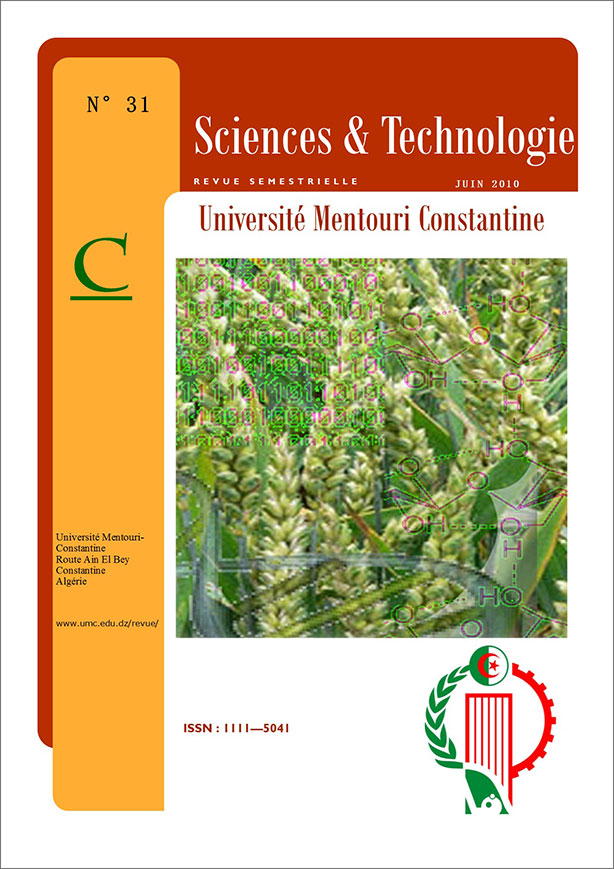FORMULATION OF STREPTOMYCES ANTAGONIST WITH INERT AND ORGANIC CHARGES AGAINST MYCOSPHAERELLA FOOT ROT AND BLIGHT
Mots-clés :
Talc formulation, Streptomyces, Antagonism, Mycosphaerella pinodes, Foot rot, Ascochyta blightRésumé
Peas is highly susceptible to preemergence damping off, caused by Mycosphaerella pinodesin western Algerian regions. Rhizosphere actinomycetes which were antagonistic this pathogen was isolated from chellif soils. An isolate of Streptomyces(St7c5) provided
superior seed protection. Increased in both the germination and plant growth were recorded following treatment of seeds with Streptomycesformulated with inert or organic charge when compared to control. Application of the antagonist agent resulted in a significant reduction of Mycosphaerellafoot rot to 5% compared tountreated seeds (30.5%).
Application of Streptomycesresulted in a significant reduction of blight symptoms when compared to the control or when treated with talc alone. Hence, the talc formulation of Streptomycesagent can be recommended as one of the crop strategies for the management of foot rotting and blight caused by Mycosphaerella pinodes.
Références
-BEALE, R. E., and PITT.D. 1990. Biological and integrated control of Fusarium basal rot of Narcissus using Minimedusa polyspora and other microorganisms. Plant Pathology 39(3), 477 - 488
-BOUZNAD.Z.1988. Contribution à la connaissance du genre Ascochyta chez les Légumineuses. Etude biologique, Ultrastructurale et Cytochimique des relations hôte parasite chez le couple Ascochyta pisi lib (Pisum sativum L.) thèse. Doc.Etat.123p.
-BUCHANAN. R.D., and GIBONS. N.E.1974. Bergy’s manual of determinative Bacteriology. 8thed. Williams & Wilkins, Baltimore.
-CHANG I., KOMMEDAHL. T., 1968. Biological control of seedling blight of corn by coating kernels with antagonistics microorganisms. Phytopathology 58: 1395-1401.
-COOK, R. J. 1993. Making Greater Use of Introduced
Microorganisms for Biological Control of Plant Pathogens. Annual review of phytopathology 31, 53-80
-CRAWFORD, D. L., LYNCH. J. M., WHIPPS, J. M., and OUSLEY. M. A. 1993. Isolation and Characterization of Actinomycete Antagonists of a Fungal Root Pathogen. Applied and Environmental Microbiology, 59(11): 3899-3905
-El-ABYAK, M. S., El-SAYED, M. A, ElSHANSHOURY, A. R. and El-SABBAGH. S. M.1993. Toward the biological control of fungal and bacterial diseases of isolation and characterization of actinomycete antagonists of a fungal root their influence
on plant growth. Plant Soil 56:475–483.
-KLOEPPER. JW, LIFSHITZ.R, SCHROTH.MN.1988. Pseudomonas inoculants to benefit plant production. Annual Plant Sci 1: 60-64.
-KOMMEDAHL. T., 1983. Biological control of soilborne pathogens: Introduction (abstract.).Phytopathology 73: 776.
-MATHIVANAN. N, SRINIVASAN.K, CHELLIAH.S.2000a. Biological control of soilborne diseases in cotton, eggplant, okra and sunflower by Trichoderma viride.Z.Pflzkrank.PflShutz 107: 235-244.
-MATHIVANAN.N, PRABAVATHY.V.R., VIJAYANANDRAJ.V.R.2005. Application of talc formulations of Pseudomonas fluorescens Migula and Trichoderma viride decrease the sheath blight disease and inhance the plant growth and yield in rice. J.Phytopathology 153:697-701.
-MEHROTRA, R. S., and SINGH. P. J. 1980. Biological control of Rhizoctonia bataticola on gram by coating seed with Bacillus and Streptomyces spp. and pathogen. Appl. Environ. Microbiol. 59:3899–3905.
-ROTHROCK. C.S., and GOTTLIEB, D.1981. Importance in antibiotic production in antagonism of selected Streptomyces species to two soilborne pathogens. J. Antibiot.34: 830-835.
-SABARATNAM, S. TRAQUAIR, J.A.2002. Formulation of a Streptomycesbiocontrol agent for the suppression of Rhizoctoniadamping-off in tomato transplants. Biological Control. 23(3):245-253.
-SAVITRY.S., GUANAMANICKAM.S.S.1987. Bacterization of peanut with Pseudomonas for biological control of Rhizoctonia solani and for enhanced yield. Plant Soil 102: 11-15.
-THIRUP.L, JOHANSEN.A., WINDING.A.2003. Microbial succession in the rhizosphere of live and decomposing in barly roots as affected by the antagonistic strains Pseudomonas fluorescens D.R.54-BN14 or the fungicide IMIZALIL. FEMS Microbiol Ecol 43:383-392.
-TIVOLI.B.1998. L’anthracnose de pois protéagineux,
comprendre, évaluer sa nuisibilité pour mieux raisonner
la protection de la culture. Phytoma 512 : 6-20.
-WALKER, R, POWELL.A.A, SEDDON.B. (1998). Bacillus isolates from the spermosphere of peas and dwarf French beans with antifungal activity against Botrytis cinerea and Pythium species. Journal of Applied Microbiology 84 (5), 791–801.
-WALTER M. YUAN AND. CRAWFORD. D. L.1995. Characterization of Streptomyces lydicus WYUC108 as a potential biocontrol agent against fungal roots and seed rots.Applied and Environnmental Microbiology, Vol. 61,(8): 3119–3128.
-WEINHOLD, A.R., and BOWMAN, T. 1968. Selective inhibition of the potato scab pathogen by antagonistic bacteria and substrate of infoluence on antibiotic production. Soil Sci.28: 12-23.
-WINDHAM, MT, ELAD. Y, BAKER.R.1986. A mechanism forincreased plant growth by Trichoderma spp. Phytopathology 76: 518-521.
